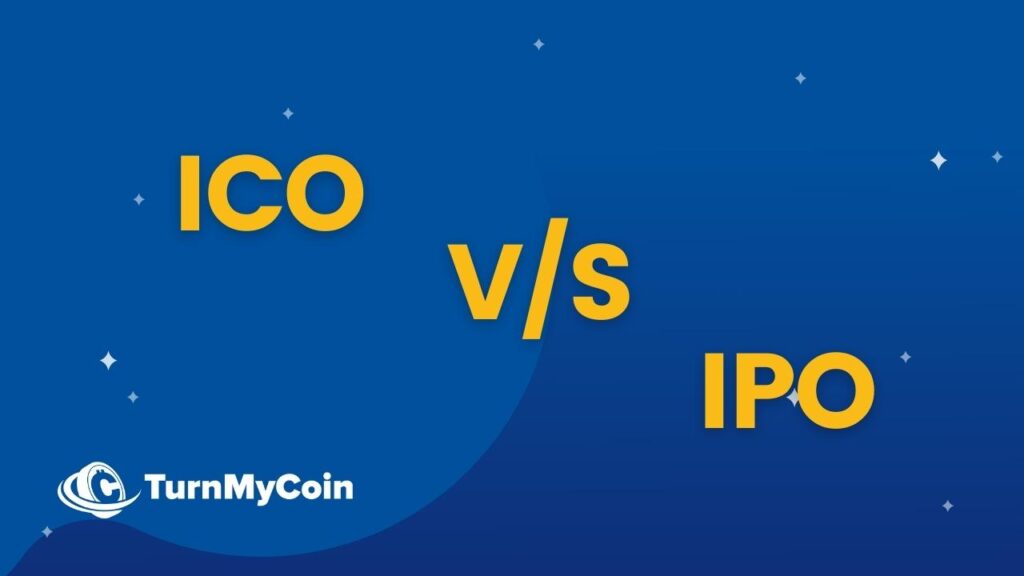Last updated on March 23rd, 2023 at 01:14 pm
Introduction
The world is being steadily overtaken by cryptocurrencies, Bitcoin being just one of them. There are now many fascinating investment opportunities available. Initial Coin Offerings (ICOs), a kind of cryptocurrency funding, are one of these investing options.
This article continues on the fundamentals of initial coin offerings (ICOs) and how they stand against IPOs. In short, this article will enlighten you on the comparison – ICO Vs IPO.
Before we begin, if you are looking to buy your first Bitcoin or other Cryptocurrency you can do so at Kucoin here and get sign up bonus of $500.
1. Meaning: ICO Vs IPO
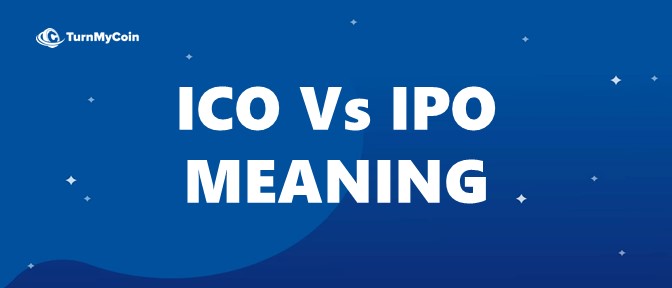
What is ICO?
The counterpart of an IPO in the cryptocurrency world is called an initial coin offering (ICO). An ICO can be started by projects that want to raise funds to develop a new coin, software, application, or service.
To get a brand-new cryptocurrency token that the business has issued, interested investors can invest in an initial coin offering. A share in the business or project may be represented by this token, which may also have some utility concerning the good or service the company is providing.
For example, a Binance Coin (BNB) is used to pay fees on the Binance Smart Chain. You can also use BNB to get a discount on the Trading Fees when you trade through the Binance Exchange
What is IPO?
An initial public offering (IPO) is the procedure of releasing shares to the public for the first time in a private firm. A business can raise equity funding from the general public through an IPO.
Since there is often a share premium for present private investors, the transition from a private to a public company can be a crucial time for private investors to completely realize rewards from their investment. Additionally, it enables retail investors to take part in the sale.
2. Working of Instruments – ICO Vs IPO
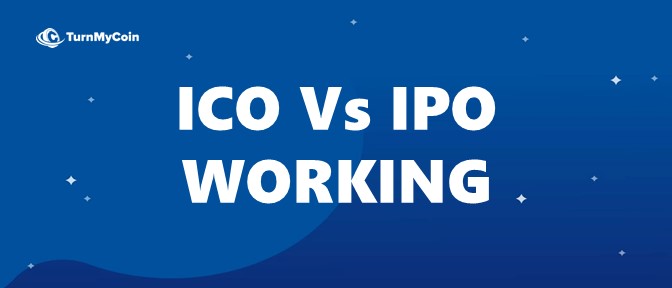
How Does ICO Work?
Though we have an exhaustive article on ICOs and their working here. It is important to mention a bit about it here for the comparison of ICO Vs IPO.
The first stage for project organizers who want to fundraise with an ICO is to decide how they will structure the coin. ICOs can be launched in many ways, including
1. Static Supply and Static Pricing
A business may establish a certain funding objective or cap, in which case each token sold during the ICO will have a defined price and a fixed supply.
2. Static Supply and Dynamic Prices
With a static supply of tokens and a dynamic funding target, an ICO can set a fixed price per token, with the overall price per token being determined by the total amount of cash raised during the ICO.
3. Dynamic Supply and Static Prices
The amount of financing received influences the supply in some initial coin offerings (ICOs) that have a dynamic token supply but a static price.
How Does IPO Work?
A business is considered private before going public. It is developed as a pre-IPO private company with a very limited number of owners, comprising early investors like the founders, family, and friends as well as qualified investors like venture capitalists or angel investors.
An IPO is a significant milestone for a business since it gives it access to a large source of funding namely, the Public at large. As a result, the business is better able to develop and prosper. Since an IPO requires more compliance, transparency, and credit analysis it is easier to borrow money at better terms.
A company will start to publicize its interest in going public once it has reached the point in its growth process where it feels it is ready for the demands of SEC (Securities & Exchange Commission) regulations (in the case of US entities) as well as the advantages and obligations to public shareholders.
Typically, a company enters this stage of growth when it achieves unicorn status or a private valuation of about $1 billion. However, private businesses with solid fundamentals and demonstrated profitability potential at varying valuations may also be eligible for an IPO, subject to market competition and their capacity to satisfy listing standards.
Through underwriting due diligence, IPO shares of a firm are valued. When a firm goes public, the shares become publicly owned, and the existing private shareholders’ shares are available for public trading. Additionally, unique clauses allowing private to public share ownership may be included in the share underwriting.
3. What is the Process of Listing ICO Vs IPO
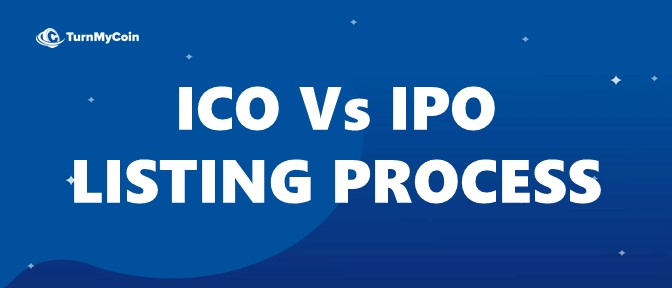
ICOs Process of Listing
A. Whitepaper Release
Along with organizing the ICO, the crypto project typically produces a white paper, known as a pitchbook in the crypto business, which it makes accessible to potential investors via a dedicated website specifically created for the project. The project’s promoters go through key details about the ICO in their white paper:
- What the initiative is about, first.
- The requirement that the project would satisfy after completion.
- How much cash is needed for the project?
- The number of digital tokens the founders will retain.
- What forms of payment (and in what currencies) are accepted?
- For how long will the ICO campaign run?
The project makes the white paper available as a part of its ICO campaign, which it intends to use to persuade enthusiasts and backers to purchase some of the project’s tokens.
For the most part, investors can use fiat or digital currency to purchase the new tokens, while it’s becoming more and more normal for investors to pay using other types of cryptocurrency like Bitcoin or Ethereum.
B. What Happens to The Funds?
Investors in the project may receive their money back if the amount raised during an ICO falls short of the minimum amount required per the ICO’s criteria. Then, the ICO would be viewed as a failure.
If the necessary financing is acquired within the time allotted, the funds raised are used to carry out the objectives of the project like the development & marketing of the project.
C. Who Can Launch ICO?
An ICO can be started by anyone. Since there is currently little regulation of ICOs in the United States, anyone with access to the necessary technology is free to introduce a new coin.
Normally Exchanges like Binance, Kucoin, Huobi also help developers launch their projects.
Accordingly, ICOs can be termed as highly risky financial investments. Though returns associated with successful ICOs are also high.
D. Buying Into an ICO
Make sure to complete your research if you’re set to invest in a new ICO that you’ve heard about. Making sure the folks launching the ICO are genuine and trustworthy is the first step.
Next, look at the blockchain and cryptocurrency experience of the project leads. A red flag is if it appears that no one with relevant, easily notable experience is involved in the project.
If you are planning to launch an ICOs. Do consider whether your project would significantly gain from one.
ICO Hyping
There is a lot of enthusiasm surrounding ICOs, and there are lots of internet forums where investors meet to talk about fresh chances. Several well-known celebrities, including Steven Seagal, have urged their followers or fans to invest in a trending new initial coin offering (ICO).
DJ Khaled and boxing legend Floyd Mayweather Jr. once promoted Centra Tech, an ICO that ended in 2017 with $30 million in funding. After Centra Tech was finally revealed to be a fraud in court, the two celebrities settled with American regulators and three of the company’s founders admitted to ICO fraud.
Before taking part in an ICO, investors looking to invest should become familiar with cryptocurrencies and learn everything there is to know about ICOs. Prospective investors should act with great caution because ICOs are hardly vetted.
What is the IPO Process?
Essentially, there are two steps in the IPO process. The first is the offering’s pre-marketing stage, and the second is the actual first public offering. To attract underwriters’ attention when a company is considering an IPO, it will either solicit private bids or make a public announcement.
The underwriters are picked by the company and take the lead in the IPO process. To oversee an IPO process, a firm may select one or several underwriters. The underwriters are involved in all stages of the IPO, including preparation of the paperwork, filing, marketing, and issuance.
Steps to an IPO
A. Proposals
The proposals and valuations that underwriters make cover their services, the appropriate kind of security to issue, the offering price, the number of shares, and the anticipated period for the market offering.
B. Underwriter
Through an underwriting agreement, the corporation formally accepts underwriting terms and selects its underwriters.
C. Team
Securities and Exchange Commission (SEC) experts, lawyers, certified public accountants (CPAs), and underwriters work together to establish IPO teams.
D. Documentation
The company’s data is collected for the necessary IPO paperwork. The main IPO filing document is the S-1 Registration Statement. The prospectus and the privately held filing information make up its two components.
The S-1 contains preliminary details concerning the anticipated filing date. In the course of the pre-IPO process, it will be modified frequently. The prospectus that is presented is also updated frequently.
E. Updates & Marketing
The pre-marketing of the new stock issuance involves the creation of marketing materials. To gauge demand and set a final offering price, management and underwriters publicize the share issuance.
Throughout the marketing process, underwriters can modify their financial analysis. They may decide to alter the IPO price or the issuing date as a result.
Companies take the required actions to satisfy particular public share offering criteria. Firms are required to abide by SEC regulations for public companies as well as exchange listing requirements.
F. Processes & Board
Organize a board of directors and make sure there are procedures for submitting quarterly reports of auditable financial and accounting data.
G. Issue of Shares
An IPO date is when the firm offers its shares. Cash is obtained through the main issuance of capital to shareholders and is reported as stockholders’ equity on the balance sheet.
Consequently, the value of each share on the balance sheet is entirely based on how much stockholders’ equity there is in the company.
H. Post-IPO
It is possible to implement some post-IPO provisions. After the initial public offering (IPO) date, underwriters could have a set length of time to purchase further shares. While this is happening, certain investors might experience quiet times.
I. Investing in an IPO
A company will only opt to raise funds through an IPO after giving it serious thought and studying to see whether this specific exit plan would maximize the rewards for early investors and generate the most money for the business.
As a result, there are likely to be many public investors waiting in line to purchase shares for the first time when the decision to launch the IPO is made. IPOs are sometimes discounted to encourage sales, which increases their allure, particularly when they draw lots of buyers from the initial issuance.
4. Which One is More Secure? ICO or IPO
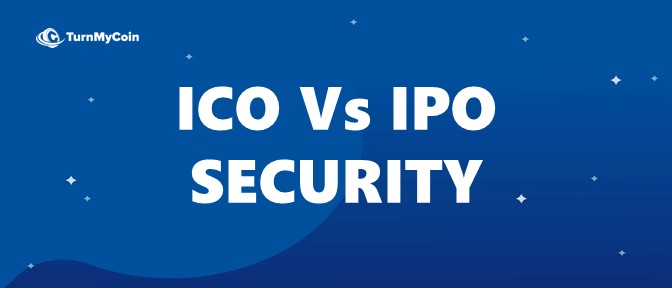
On the surface, IPOs seem to be a safer alternative to ICOs for investors as far as security is concerned.
Companies must comply with several regulations that are severely enforced for initial public offerings (IPOs). Transparency and information disclosure during the IPO process enables investors to make wise investment choices.
It does not follow, however, that ICOs are any less secure. There are lesser rules for ICOs, and the project might either be a huge success or a total bust.
But even the most reliable businesses planning IPOs have the risk of failing, wiping off your investment. Nobody has any way of knowing which investments will turn a profit and which ones won’t. Therefore, before choosing an investment, some skepticism is necessary.
Conclusion
As was previously mentioned, it is impossible to forecast with certainty whether a business or initiative will succeed or fail.
Before making an investment decision, carefully consider the benefits and drawbacks of the various options. To assist you in making wise investing decisions, we have outlined some advantages and disadvantages of IPOs and ICOs:
Pros and Cons : ICO Vs IPO
| Pros (+) and Cons (-) | IPO | ICO |
| Regulatory and legal control | ✔️ | ❌ |
| Company’s track record | ✔️ | ❌ |
| Quick investment | ❌ | ✔️ |
| Smaller investments | ❌ | ✔️ |
| Reliability | ✔️ | ❌ |
| International accessibility | ❌ | ✔️ |
